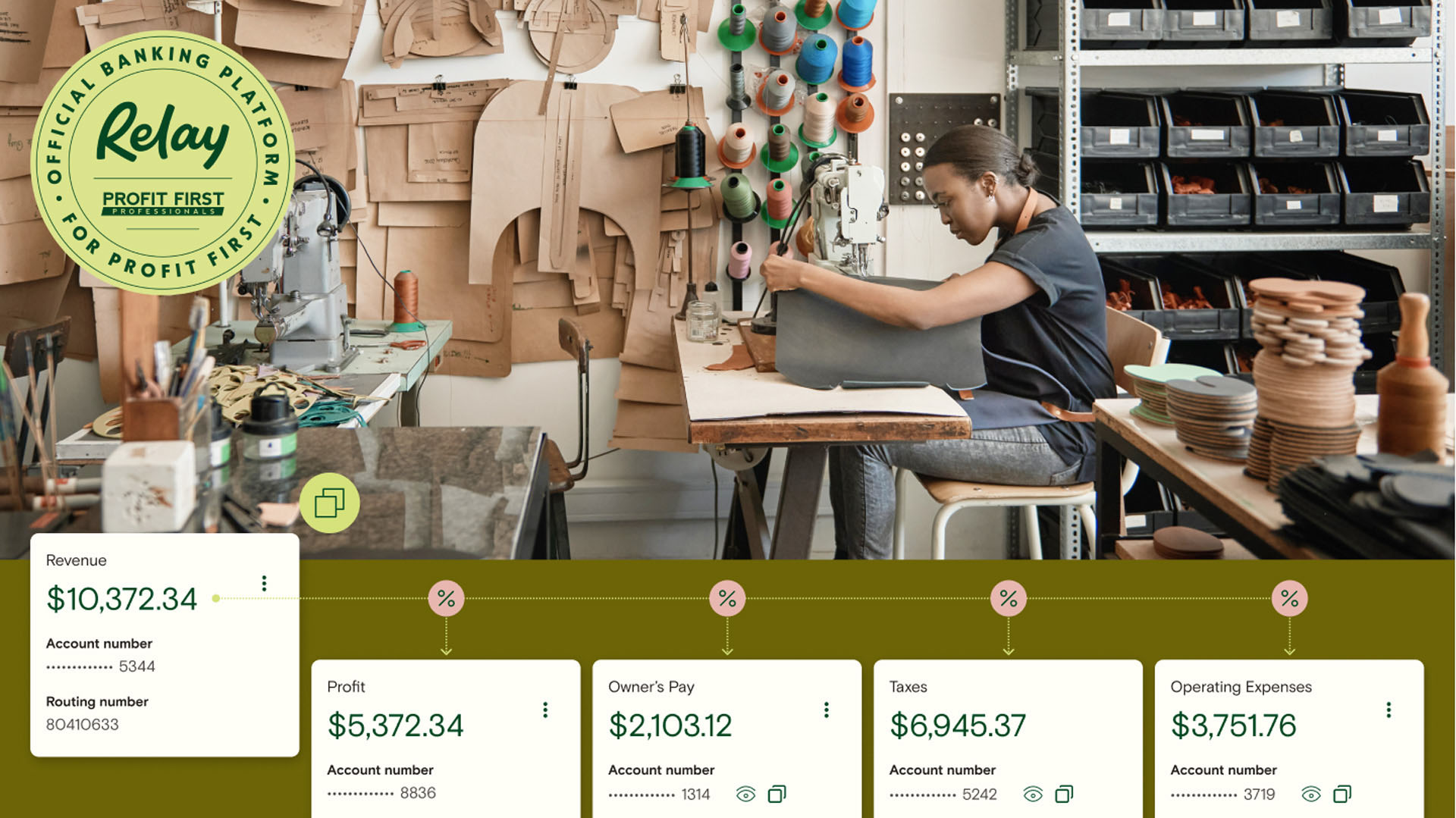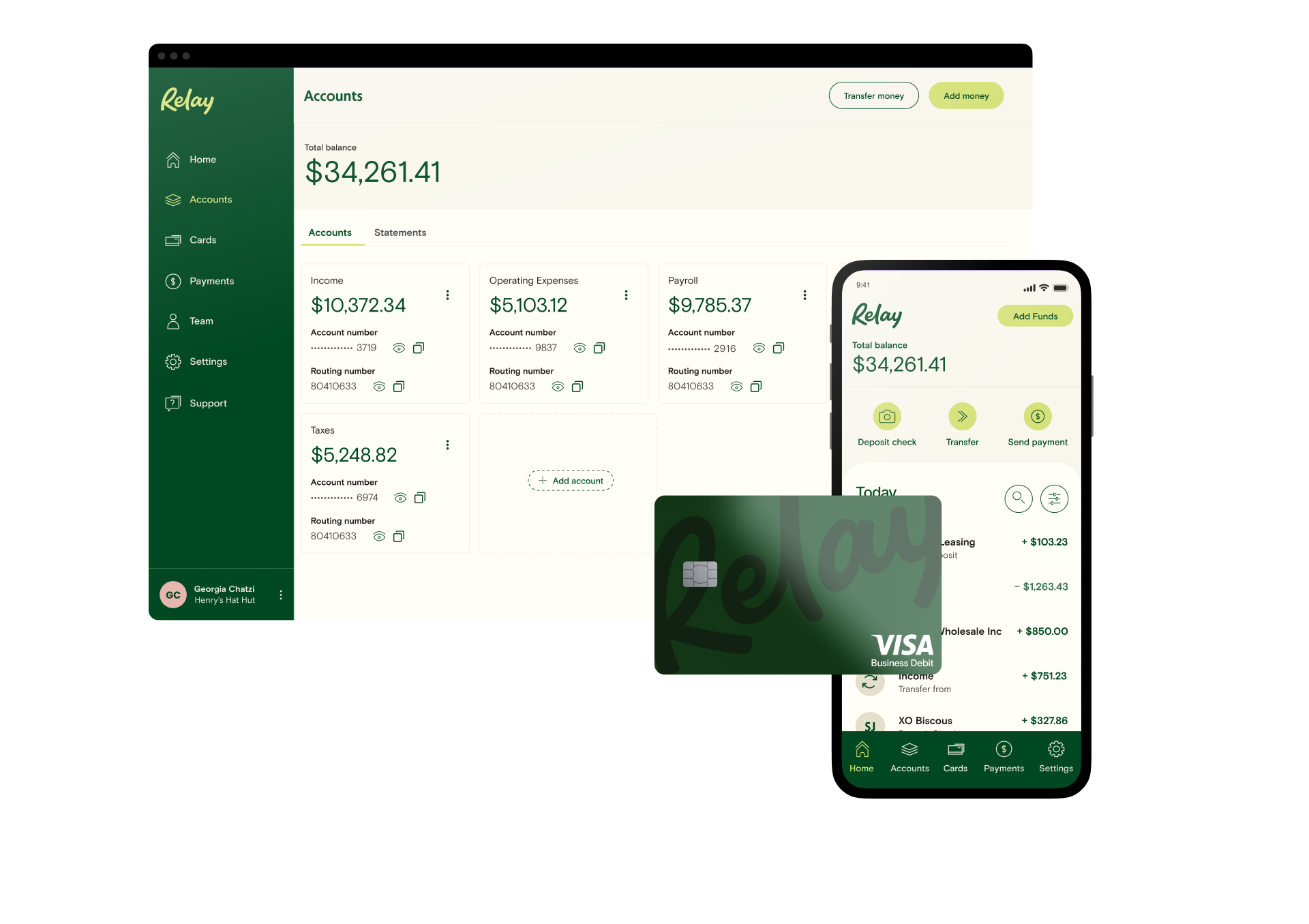Have you ever had a great sales month, only to wonder where your profit went at the end of the month? 🤔 This is a common issue business owners experience. But you may be surprised to learn there is a simple method to solving this cash flow issue. That is, prioritizing your profits over your expenses — also called Profit First. In this article, we'll take a look at the 4 best banking platforms you can use to implement Profit First.
The Profit First cash management method aims to increase your profitability by prioritizing your profits over your operating expenses.
In this article, we’ll cover:
Let’s first understand what exactly this cash management method is and compare the best business bank accounts for using the Profit First method.
What is the Profit First method?
The idea 💡 behind the Profit First cash management method is that you pay yourself first and let the remainder of your cash flow dictate how much you spend on operating expenses.
Profit First is rooted in the concept of Parkinson’s Law, where work will expand to fill the period of time available for its completion. In other words, you’ll complete your work in the amount of time you’re given. So if you have a week to complete a project, you’ll end up taking the entire week even if you could have done it in a shorter amount of time.
The same is true for your profit and expenses. If you leave your expenses unchecked, you’ll end up using more or all of your revenue. But by taking your profit out first, you can guarantee your profitability before you use your money for expenses.
For example, if the traditional profit formula looks like revenue - expenses = profit, then the Profit First formula looks like revenue - profit = expenses.
The Profit First system aims to calculate your profit by dividing your revenue into five different allocation buckets: Real Revenue, Profit, Tax, Owner’s Pay, and Operating Expenses. You can do this by setting up multiple checking accounts for each of the buckets, also known as digital envelope accounts.
The idea behind Profit First is that when you take a percentage of your revenue as profit right away, you become more profitable. You may even find that you reduce your overall expenses. Profit First allows you to safeguard your cash flow and prevents you from underpaying yourself.
Why it’s so hard to find a bank for the Profit First method
The hurdle with implementing Profit First is that most banks charge fees for every account a business owner opens — that is if they're even willing to open up multiple accounts in the first place. As a result, it can be challenging to find the right bank to effectively implement the Profit First method. Nevertheless, you have two options: traditional banking or digital banking.
Traditional brick-and-mortar banks 🏦 aren’t ideal for the Profit First method because they don’t offer multiple accounts and often charge higher account fees. Not to mention traditional banks require you to visit a physical bank location for common banking tasks, which makes banking with traditional banks a hassle.
While online banks tend to offer multiple envelope accounts (also known as sub-accounts) more often than traditional banks, it can still be challenging to understand the fees associated with each bank and choose the right one for your needs. It’s also important to understand the difference between using true checking accounts versus sub-accounts when implementing Profit First.
A sub-account is a checking account that exists within another banking account, while a checking account is a banking account with its own individual account numbers.
So, why is this important when talking about Profit First? While sub-accounts can help you organize your money into different compartments, they don’t allow you to send or receive money from one sub-account to another without first sending it back to the parent account. This makes implementing Profit First more difficult and manual.
Official banking platform for Profit First
Together, Profit First and Relay ensure that every dollar is allocated according to plan — be it paying down debt, reinvesting in your business, or taking a profit.
Learn MoreWhat to consider when choosing a Profit First bank
When searching for the best bank for Profit First, you’ll want to analyze a few important features, like the number of accounts offered, monthly fees, and transfer rules. Simply put, it’s essential that the bank you choose allows you to open multiple accounts and transfer funds, without charging you extra.
When using the Profit First method, you’ll need the following banking features:
A minimum of five (FREE) accounts: The Profit First method recommends five different accounts for cash flow allocations, including a Real Revenue account (or Income account), Profit account, Owner’s Pay account, Tax account, and Operating Expenses account. But beyond the five necessary allocation buckets, you may want more in order to get a more granular view of how your money is being spent. And with so many different accounts, the last thing you want is to be charged separately, making fee-free banking a must. You should also consider whether you want a bank with sub-accounts or true checking accounts. With sub-accounts, you won’t be able to automate the transfer of funds each month and you’ll have to make each transfer manually instead.
Percentage-based transfers: Profit First recommends allocation percentages based on your total revenue. And while the specific allocation percentages vary depending on your total revenue, the average percentages are 15% allocated to Profit, 30% to Owner’s Pay, 15% for Taxes, and 45% for operating expenses. As a business owner, you likely don’t want to make those calculations manually every month, which is why having a bank that automatically makes percentage-based transfers for you is so crucial.
Balance-based transfers: Beyond the need for percentage-based transfers, balance-based transfers can help automate your cash flow allocations. This way, you can create rules where when an account hits a certain amount of money, cash will be automatically dispersed to their other accounts based on their percentages.
Be sure to avoid banks that charge minimum balance fees, maintenance fees or other hidden fees. Let’s look at some of the best banking platforms for Profit First, given these important banking features.
Transform your business with Profit First
If you need help implementing Profit First, find a certified Profit First Professional today.
Find a Profit First ProfessionalWhat are the best banks for Profit First?
The best banks for Profit First are those without fees that allow you to open multiple accounts or envelopes. While having true checking accounts will allow you to transfer your cash reserves automatically, you can do this manually if you choose a bank with envelope accounts.
Let’s dig into a few of the best banks for implementing the Profit First method.
Relay

Relay is the official banking platform for Profit First. When you bank with Relay, you get essential features that keep you on the money and help you put Profit First into action. This includes up to 20 real no-fee checking accounts (not just envelopes!), percentage-based transfers between accounts, and auto-transfer rules that help you easily set aside cash reserves for your Profit First system.
Mike Michalowicz on Relay:
Features:
✅ Up to 20 free checking accounts: With no fees or minimum balances on any of your accounts, you have the ability to set up deposit-only accounts, as well as operating expense accounts. This gives you greater clarity into your profitability.
✅ Percentage-based transfers: You shouldn’t have to spend time manually calculating your percentages each month, which is why Relay does it for you. Relay offers a percentage-based transfer making it incredibly easy to automate account transfers into each of your allocation buckets.
✅ Multiple LLCs under one login: If you run a business that has multiple accounts under separate legal entities, banking can be quite chaotic. But Relay allows for multiple business entities under one login, so you can have visibility into your profitability across all accounts.
✅ 50 physical or virtual debit cards: Relay offers up to 50 debit cards that can be assigned spending limits to help you quickly understand where your money is going. This allows you to better organize spending across different departments and team members.
✅ Relay is the official banking platform for Profit First: We’ve partnered up with Profit First Professionals to give you the best experience possible. Together, Profit First and Relay ensure that every dollar is allocated according to plan — be it paying down debt, reinvesting in your business, or taking a profit.
Cons:
❌ No credit cards
Banking Built for Business Owners
No account fees or minimums; 20 checking accounts; 2 savings accounts with 1.00%-3.00% APY; 50 virtual + physical debit cards. Open account 100% online.
Learn moreIf you’re ready to give Profit First a try, open a free Relay account in just a few minutes today!
Bluevine

Bluevine is a digital banking platform that offers a high-yield business checking account. Eligible customers earn 2.0% APY on balances up to and including $100,000. Bluevine does not charge monthly fees, minimum balance requirements or overdraft fees. With a Bluevine checking account, you get access to 5 sub-accounts which is just enough to implement the Profit First method.
Features:
🟨 Up to five sub-accounts: You get up to five sub-accounts with your Bluevine checking account. While this is sufficient for the Profit First method, you won’t have wiggle room to create any more cash allocation reserves.
✅ Eligible customers earn 2% interest: Bluevine offers 2.0% interest on qualifying business checking accounts. Accounts must meet one of the following criteria to qualify for Bluevine’s APY of 2.0%: Spend $500 or more in a month using their Bluevine debit card, or, receive $2,500 per month in customer payments through ACH, wire transfer, mobile app check deposit, or a merchant payment processing provider.
Cons:
❌ $15 domestic wire transfer fee
❌ No international wires
❌ No percentage-based transfers
Bank of America

Bank of America offers two types of checking accounts for small businesses: Business Advantage Fundamentals Banking and Business Advantage Relationship Banking. Each comes with features like virtual debit cards, cash flow monitoring, and profile linking designed to help small businesses manage multiple accounts under one login.
Features:
✅ Extensive network of branches and ATMs: For some businesses, the branch experience is a major factor to consider when choosing a bank. With Bank of America, you have access to over 4,200 branches and 16,000 ATMs across 37 states.
✅ Full suite of financial services for both personal and business banking: Bank of America offers a number of banking products, including checking accounts, loans, lines of credit, and credit cards. They're perfect for businesses looking for a one-stop shop for all their financial needs. Plus, if you use Bank of America for both personal and business banking, you can have one centralized login for personal and business accounts.
✅ Access to Preferred Rewards: The more you bank and invest with Bank of America, the more rewards and discounts they offer. For example, you can get additional cashback on credit card purchases, additional interest on savings accounts, exchange rate discounts on foreign currency and account fees waived based on their reward tiers.
Cons:
❌ Only 1 debit card
❌ Only 1 true checking account
❌ Lots of incidental and transaction fees
❌ No percentage-based transfers
If you prefer to work with a traditional bank, Bank of America is a good option.
Your local credit union
Local credit unions are a great option for Profit First banking. Since they're usually local or regional, they tend to provide a more personal service compared to larger commercial banks.
When you bank with a credit union, they get to know you personally and are thus more willing to waive fees or offer you additional checking accounts based on your banking needs. Due to their flexibility, they can be Profit First friendly. However, credit unions often lack robust banking features when compared to traditional banks and neobanks.
Credit unions are not-for-profit institutions, with federal credit unions being exempt from federal taxes. This means, they usually have lower fees and minimum balances on accounts.
Features:
✅ Better customer service compared to big banks — tend to be more flexible when it comes to allowing multiple accounts
✅ No fees or minimum balance requirements
✅ Tend to have more competitive interest rates on savings accounts
✅ Funds are insured by the National Credit Union Administration (NCUA) up to $250K
Cons:
❌ Less technologically advanced, may not have online or mobile banking options
❌ May have fewer banking features and integrations with money apps like Stripe
❌ Fewer physical branches
❌ No percentage-based transfers
Relay for Profit First banking
When searching for the best banking services for Profit First, it’s important to choose a bank that grows with your business. Relay does just that with up to 20 free checking accounts, percentage-based transfers and a suite of accounts payable features to make bookkeeping easier than ever.
Banking Built for Business Owners
No account fees or minimums; 20 checking accounts; 2 savings accounts with 1.00%-3.00% APY; 50 virtual + physical debit cards. Open account 100% online.
Learn moreIf you’re ready to give Profit First a try, open a free Relay account in just a few minutes today!






